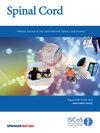The potential role of RhoA/ROCK-inhibition on locomotor recovery after spinal cord injury: a systematic review of in-vivo studies
IF 2.1
4区 医学
Q3 CLINICAL NEUROLOGY
引用次数: 0
Abstract
Systematic Review. To thoroughly assess the existing literature regarding the impact of anti-RhoA/ROCK agents or procedures on functional recovery in animal models of SCI. Sina Trauma and Surgery Research Center, Tehran University of Medical Sciences. A comprehensive search was conducted in Ovid MEDLINE, Embase, Scopus, and Web of Science Core Collection utilizing a combination of keywords. All in-vivo animal studies of acute or chronic SCI that evaluated the pharmacological effects of Rho/ROCK inhibitors in English literature were included in this study. Totally, 2320 articles were identified, of which, 60 papers were included for further analysis. A total of 47 (78%) studies were conducted merely on rats, 9 (15%) on mice, 3 (5%) used both, and the remaining used other animals. Y-27632, Fasudil, C3 Transferase and its derivatives (C3-05/PEP-C3/CT04/C3bot154–182/C3bot26mer(156–181)), Ibuprofen, Electroacupuncture (EA), SiRhoA, miR-133b, miR-135-5p, miR-381, miR-30b, Statins, 17β-estradiol, β-elemene, Lentivirus-mediated PGC-1a, Repulsive guidance molecule (RGMa), Local profound hypothermia, Jisuikang (JSK), Hyperbaric oxygen (HBO), Lv-shRhoA (Notch-1 inhibitor), Anti-Ryk antibody, LINGO-antagonist, BA-210, p21Cip1/WAF1, ORL-1 antagonist, Epigallocatechin‐3‐gallate (EGCG), Tamsulosin, AAV.ULK1.DN, and Indomethacin were the 28 reported agents/procedures with anti-RhoA/ROCK effects. The pooled SMD for BBB scores was 0.41 (p = 0.048) in the first week, 0.85 (p < 0.001) in the second week, 1.22 (p = 0.010) in the third week, and 1.53 (p = 0.001) in the fourth week. Of the 28 identified anti-RhoA/ROCK agents, all but two (C3bot and its derivatives and EGCG) demonstrated promising results. The results of the meta-analysis cautiously indicate a significant increase in BBB scores over time after SCI.

求助全文
约1分钟内获得全文
求助全文
来源期刊

Spinal cord
医学-临床神经学
CiteScore
4.50
自引率
9.10%
发文量
142
审稿时长
2 months
期刊介绍:
Spinal Cord is a specialised, international journal that has been publishing spinal cord related manuscripts since 1963. It appears monthly, online and in print, and accepts contributions on spinal cord anatomy, physiology, management of injury and disease, and the quality of life and life circumstances of people with a spinal cord injury. Spinal Cord is multi-disciplinary and publishes contributions across the entire spectrum of research ranging from basic science to applied clinical research. It focuses on high quality original research, systematic reviews and narrative reviews.
Spinal Cord''s sister journal Spinal Cord Series and Cases: Clinical Management in Spinal Cord Disorders publishes high quality case reports, small case series, pilot and retrospective studies perspectives, Pulse survey articles, Point-couterpoint articles, correspondences and book reviews. It specialises in material that addresses all aspects of life for persons with spinal cord injuries or disorders. For more information, please see the aims and scope of Spinal Cord Series and Cases.
 求助内容:
求助内容: 应助结果提醒方式:
应助结果提醒方式:


